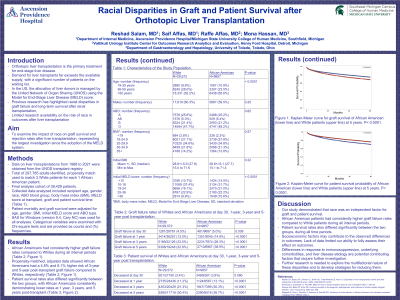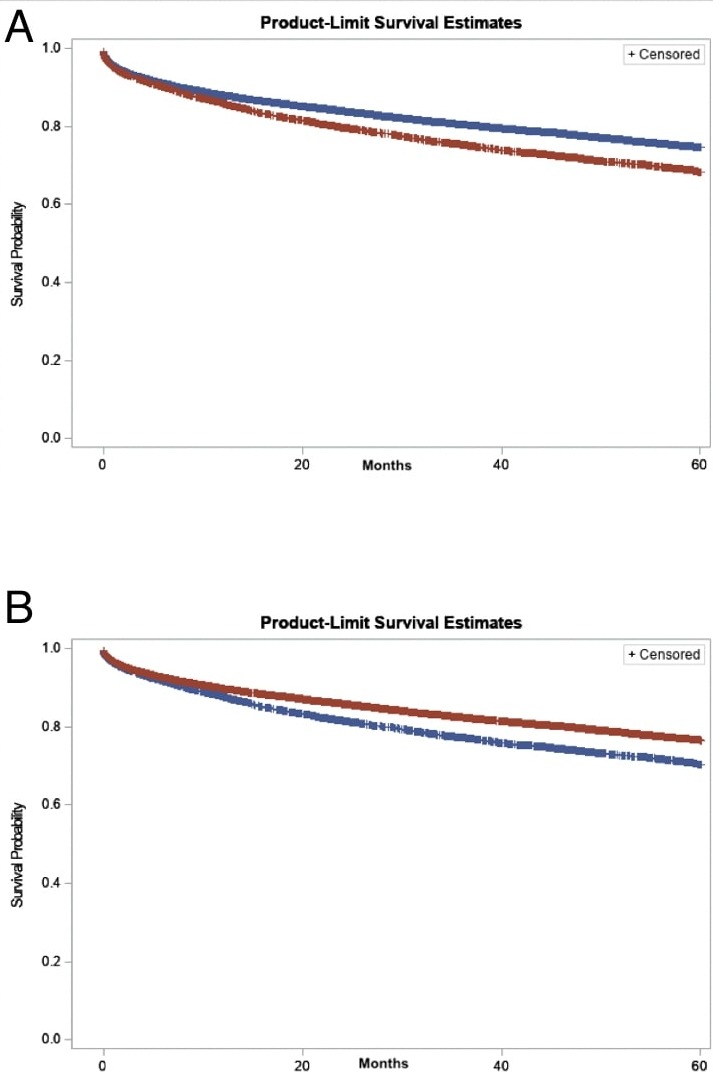Tuesday Poster Session
Category: Liver
P3779 - Racial Disparities in Graft and Patient Survival After Orthotopic Liver Transplantation
Tuesday, October 24, 2023
10:30 AM - 4:00 PM PT
Location: Exhibit Hall

Has Audio

Reshad Salam, MD
Ascension Providence Hospital/Michigan State University
Southfield, Michigan
Presenting Author(s)
Award: Presidential Poster Award
Reshad Salam, MD1, Saif Affas, MD2, Raffe Affas, MD3, Mona Hassan, MD4
1Ascension Providence Hospital/Michigan State University, Southfield, MI; 2Ascension Providence Hospital, Troy, MI; 3Henry Ford Hospital, Detroit, MI; 4University of Toledo, Toledo, OH
Introduction: There is limited data on the influence of race on graft rejection and survival after liver transplantation. Our study is the largest to investigate racial disparities in outcomes after primary liver transplantation since the implementation of the Model for End-Stage Liver Disease (MELD) classification system. We sought to determine if there is a difference in graft survival and patient survival in African Americans (AA) compared to white Americans after liver transplantation.
Methods: Data on liver transplantations between 1988 and 2021 was obtained from the United Network of Organ Sharing (UNOS) transplant registry. The registry contained complete follow up data for 326,005 patients. A propensity type of match was used to match 3 white patients for each of the AA patients. The pool of data extracted included information on recipient age, gender, race, ABO blood group, donor type, donor age, body-mass index (BMI), Model for End-Stage Liver Disease (MELD) score at time of transplant, graft and patient survival time. Statistical Analysis Software (SAS) for Windows, version 9.4, Cary NC was used for all analyses. Categorical variables were examined with Chi-square tests and are provided as counts and (%) frequencies.
Results: Graft failure rates between whites and AA on day 30 post liver transplant (4.5% vs 5.0%, p=0.036), 1 year (13.0% vs 14.9%, p< 0.0001), 3 years (23.5% vs 28.3%, p< 0.0001) and 5 years (32.8% vs 38.9%, p< 0.0001). Additionally, patient mortality between whites and AA at day 30 (3.4% vs 3.8%, p=0.90), 1 year (11.2% vs 13.1%, p< 0.0001), 2 years (21.3% vs 26.3%, p< 0.0001), 5 years (30.4% vs 36.7%, p< 0.0001). Both were adjusted for age, gender, BMI, Initial MELD score and ABO type. This data resulted in an increasing gap between the two racial groups on the Kaplan-Meier plot for graft survival and patient survival.
Discussion: Our study successfully demonstrates that African Americans have a statistically significant higher graft failure and patient survival rate compared to white Americans at 1 year, 3 years and 5 years post-OLT. The reasons for these differences are likely multifactorial in nature. The results of this study highlight the need for further research to understand the factors affecting the survival outcomes of different racial/ethnic groups and address disparities in healthcare.

Disclosures:
Reshad Salam, MD1, Saif Affas, MD2, Raffe Affas, MD3, Mona Hassan, MD4. P3779 - Racial Disparities in Graft and Patient Survival After Orthotopic Liver Transplantation, ACG 2023 Annual Scientific Meeting Abstracts. Vancouver, BC, Canada: American College of Gastroenterology.
Reshad Salam, MD1, Saif Affas, MD2, Raffe Affas, MD3, Mona Hassan, MD4
1Ascension Providence Hospital/Michigan State University, Southfield, MI; 2Ascension Providence Hospital, Troy, MI; 3Henry Ford Hospital, Detroit, MI; 4University of Toledo, Toledo, OH
Introduction: There is limited data on the influence of race on graft rejection and survival after liver transplantation. Our study is the largest to investigate racial disparities in outcomes after primary liver transplantation since the implementation of the Model for End-Stage Liver Disease (MELD) classification system. We sought to determine if there is a difference in graft survival and patient survival in African Americans (AA) compared to white Americans after liver transplantation.
Methods: Data on liver transplantations between 1988 and 2021 was obtained from the United Network of Organ Sharing (UNOS) transplant registry. The registry contained complete follow up data for 326,005 patients. A propensity type of match was used to match 3 white patients for each of the AA patients. The pool of data extracted included information on recipient age, gender, race, ABO blood group, donor type, donor age, body-mass index (BMI), Model for End-Stage Liver Disease (MELD) score at time of transplant, graft and patient survival time. Statistical Analysis Software (SAS) for Windows, version 9.4, Cary NC was used for all analyses. Categorical variables were examined with Chi-square tests and are provided as counts and (%) frequencies.
Results: Graft failure rates between whites and AA on day 30 post liver transplant (4.5% vs 5.0%, p=0.036), 1 year (13.0% vs 14.9%, p< 0.0001), 3 years (23.5% vs 28.3%, p< 0.0001) and 5 years (32.8% vs 38.9%, p< 0.0001). Additionally, patient mortality between whites and AA at day 30 (3.4% vs 3.8%, p=0.90), 1 year (11.2% vs 13.1%, p< 0.0001), 2 years (21.3% vs 26.3%, p< 0.0001), 5 years (30.4% vs 36.7%, p< 0.0001). Both were adjusted for age, gender, BMI, Initial MELD score and ABO type. This data resulted in an increasing gap between the two racial groups on the Kaplan-Meier plot for graft survival and patient survival.
Discussion: Our study successfully demonstrates that African Americans have a statistically significant higher graft failure and patient survival rate compared to white Americans at 1 year, 3 years and 5 years post-OLT. The reasons for these differences are likely multifactorial in nature. The results of this study highlight the need for further research to understand the factors affecting the survival outcomes of different racial/ethnic groups and address disparities in healthcare.

Figure: Figure 1: (A) Kaplan-Meier Curve for graft survival of black and white patients at 5 years. Blue line represents white Americans, red line represents African Americans, P< 0.0001. (B) Kaplan-Meier Curve for patient survival probability of black and white patients at 5 years. Red line represents white Americans, blue line represents African Americans, P< 0.0001.
Disclosures:
Reshad Salam indicated no relevant financial relationships.
Saif Affas indicated no relevant financial relationships.
Raffe Affas indicated no relevant financial relationships.
Mona Hassan indicated no relevant financial relationships.
Reshad Salam, MD1, Saif Affas, MD2, Raffe Affas, MD3, Mona Hassan, MD4. P3779 - Racial Disparities in Graft and Patient Survival After Orthotopic Liver Transplantation, ACG 2023 Annual Scientific Meeting Abstracts. Vancouver, BC, Canada: American College of Gastroenterology.

